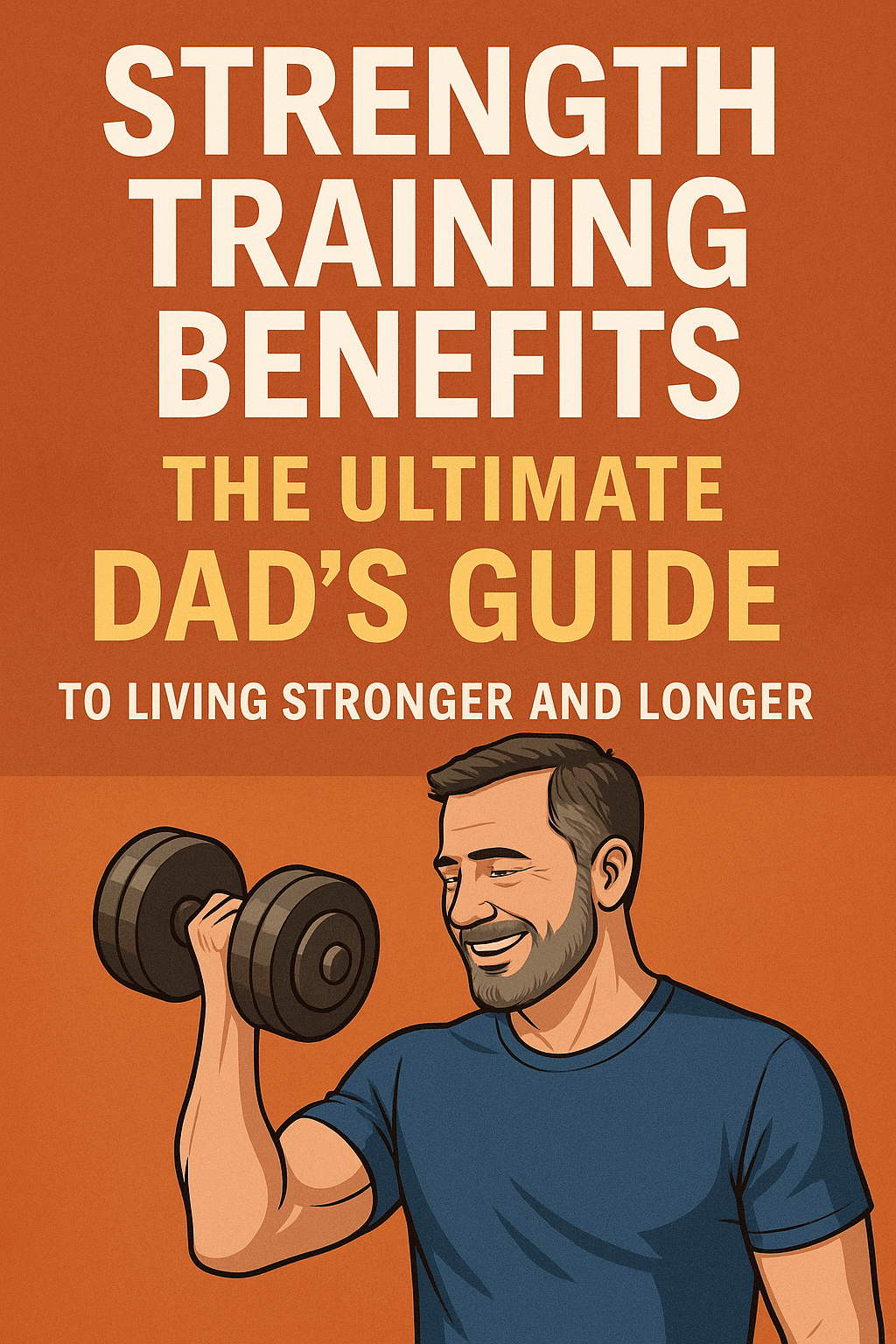Strength Training Benefits: The Ultimate Dad’s Guide to Living Stronger and Longer

Walking into the gym for the first time in my forties felt like stepping into foreign territory. All those young guys throwing around massive weights while I struggled to figure out which machine did what. But here’s what nobody tells you about resistance training: it’s not about impressing anyone else—it’s about adding years to your life and life to your years.
The science is crystal clear. Strength training benefits extend far beyond bigger biceps and a firmer chest. We’re talking about reducing your risk of death by up to 20%, protecting your brain from decline, and ensuring you can still chase your grandkids around the backyard when you’re 70.
Let me share what I’ve learned about why every dad needs to make strength training a non-negotiable part of his routine.
The Longevity Factor: Why Strong Men Live Longer
📌 Bottom Line Up Front: Recent studies show just 30-60 minutes of strength training per week can reduce your risk of dying from any cause by 10-17%.
The research coming out about strength training benefits for longevity is nothing short of remarkable. A 2022 study tracking 115,000 people 65 and older found that adding strength training to aerobic exercise lowered the risk of dying, regardless of cause, over nearly eight years of follow-up. When strength training twice weekly or more was added to 2.5 hours of aerobic exercise, the risk of dying during the study period dropped by 30%.
But here’s what really got my attention: For every 1 point increase in muscle strength, a subject’s risk of Alzheimer’s dropped by 43 percent. That’s not a typo. We’re talking about nearly cutting your dementia risk in half just by getting stronger.
💡 Dad Reality Check: You don’t need to become a powerlifter. The sweet spot for longevity appears to be around 40-60 minutes of strength training per week—that’s two 20-30 minute sessions.
The mechanism behind these strength training benefits makes perfect sense when you think about it. Muscle tissue is metabolically active, meaning it burns calories even when you’re sleeping. More muscle equals better insulin sensitivity, improved cardiovascular health, and stronger bones that can handle whatever life throws at you.
Breaking Down the Science: What Happens When You Lift
Let’s get real about what actually happens in your body when you start incorporating resistance training into your routine. The strength training benefits begin almost immediately, but the compound effects over time are where the magic happens.
🔍 Muscle Protein Synthesis: Every time you challenge your muscles with resistance, you trigger a repair and rebuilding process. This isn’t just about getting bigger—it’s about getting more resilient at the cellular level.
Your body starts producing something called myokines when you strength train. These are small strings of amino acids existing between muscles and the rest of the body that can help regulate various metabolic processes conducive to better cardiometabolic health. Think of them as your body’s internal messaging system, telling everything from your heart to your brain to work more efficiently.
The bone density improvements alone are worth the price of admission. Weight-bearing exercises create mechanical stress on your bones, forcing them to become denser and stronger. This is crucial for us guys who want to avoid the brittle bones and fractures that can derail our golden years.
Metabolic Changes You’ll Notice:
- Better blood sugar control after meals
- Improved sleep quality (tired muscles sleep well)
- Increased daily energy levels
- Better mood regulation
Strength Training vs. Cardio: The Great Debate Settled

Here’s where I’m going to ruffle some feathers. While cardio is important, the strength training benefits for overall health and longevity might actually be more significant.
A recent study found strength training can be even more effective than aerobic activity in controlling blood sugar in people with diabetes. But here’s the kicker—you don’t have to choose. The best approach combines both, but if you’re pressed for time (and what dad isn’t?), prioritizing resistance training might give you more bang for your buck.
👉 The Time Reality: Most of us can’t spend two hours a day in the gym. The beauty of strength training benefits is that you can achieve significant results with just two focused sessions per week.
Cardio primarily improves your cardiovascular system during the activity itself. Strength training creates adaptations that benefit you 24/7. Your increased muscle mass boosts your metabolic rate, meaning you’re burning more calories even when you’re sitting at your desk or sleeping.
The science based full body workout approach I’ve written about before shows how you can target multiple muscle groups efficiently. This isn’t about isolation exercises for each tiny muscle—it’s about compound movements that work multiple systems simultaneously.
Mental Health Benefits: The Mind-Muscle Connection
🧠 Mental Health Game-Changer: Strength training has been shown to be as effective as medication for treating mild to moderate depression.
The strength training benefits for mental health are profound and often overlooked. A meta-analysis published in the medical journal JAMA Psychiatry in 2018, which included the results of more than 30 clinical trials, found a reduction in symptoms of depression among people who did weight training two times a week or more.
But it goes deeper than just feeling good. There’s something primal and satisfying about moving heavy objects with your own strength. It connects you to your body in a way that running on a treadmill simply can’t match.
The Confidence Factor: Every time you add weight to the bar or complete a set that felt impossible last month, you’re building more than muscle—you’re building self-efficacy. That confidence carries over into every area of your life, from work presentations to parenting decisions.
I’ve noticed this personally. On days when I’ve completed a solid strength session, I handle stress better. I’m more patient with the kids, more focused at work, and generally more resilient to whatever chaos the day brings.
The family fitness activities I’ve implemented at home often revolve around strength-based movements because they teach my kids that their bodies are capable of amazing things.
Functional Strength: Training for Real Life

💪 Reality Check: The goal isn’t to look like a bodybuilder—it’s to be the dad who can effortlessly carry sleeping kids to bed, move furniture without throwing out his back, and keep up with family adventures.
This is where functional strength training shines. The strength training benefits extend far beyond the gym into every aspect of daily life. When you can deadlift your bodyweight, carrying groceries becomes trivial. When you can squat with proper form, getting up from the floor while playing with kids becomes effortless.
Essential Movement Patterns Every Dad Needs:
- Squatting: For getting down to kid level and back up again
- Deadlifting: For picking up everything from toys to luggage safely
- Pressing: For overhead storage and general upper body strength
- Pulling: For counteracting all that forward-hunched computer posture
The beauty is that these movements can be scaled for any fitness level. Start with bodyweight versions, then add resistance as you get stronger. The best supplements for weight training can support your progress, but consistency beats supplementation every time.
I’ve found that focusing on these basic patterns has eliminated the nagging back pain I used to get from sitting at a desk all day. The strength training benefits for posture and mobility are immediate and lasting.
Age-Defying Benefits: Strength Training After 40
🚨 Wake-Up Call: After age 30, we lose 3-8% of our muscle mass per decade. After 40, that rate can accelerate dramatically without intervention.
This is where strength training benefits become absolutely critical. Building muscle mass is especially important for older adults because muscle loss occurs naturally with aging and increases rapidly after 60. But here’s the good news—it’s never too late to start building back what you’ve lost.
The research on strength training benefits for older adults is incredibly encouraging. We’re not just talking about slowing decline—we’re talking about actual improvement and reversal of age-related changes.
What Happens When You Start Strength Training After 40:
- Testosterone levels often improve naturally
- Bone density increases, reducing fracture risk
- Balance and coordination improve dramatically
- Energy levels surge as metabolism increases
I started seriously strength training at 42, and I’m stronger now than I was in my twenties. That’s not bragging—that’s what happens when you consistently challenge your body with progressive resistance.
The fitness and aging article I wrote goes deeper into this topic, but the key takeaway is that age is not an excuse—it’s actually the best reason to start.
Building Your Home Strength Training Setup
✅ Budget-Friendly Truth: You don’t need a fancy gym membership to reap strength training benefits. Some of the most effective exercises use nothing but your body weight.
Setting up a budget-friendly home gym for large family has been one of my best investments. Not only does it save time and money, but it allows me to model healthy behavior for my kids every single day.
Essential Equipment for Maximum Strength Training Benefits:
- Adjustable dumbbells: Versatile and space-efficient
- Resistance bands: Perfect for travel and joint-friendly workouts
- Pull-up bar: Doorway versions work great for most homes
- Kettlebell: One moderate weight can provide a full-body workout
But honestly, you can start with absolutely nothing. Push-ups, squats, lunges, and planks will give you a solid foundation. As you get stronger, you can gradually add equipment to increase the challenge.
The key is consistency over intensity. Better to do 15 minutes of bodyweight exercises three times a week than to plan an elaborate gym routine you’ll never follow through on.
Nutrition to Maximize Strength Training Benefits

🍎 Protein Priority: Your muscles need adequate protein to recover and grow stronger. Aim for about 0.8-1 gram per pound of body weight daily.
The strength training benefits are significantly enhanced when paired with proper nutrition. This isn’t about complicated meal plans or expensive supplements—it’s about giving your body the building blocks it needs to adapt to training.
Timing Matters:
- Eat protein within 2 hours after strength training
- Don’t train on a completely empty stomach
- Stay hydrated throughout the day, not just during workouts
I’ve found that the family mealtime secrets approach I use for feeding six kids works perfectly for supporting my training. Focus on whole foods, adequate protein at each meal, and don’t overthink it.
Sleep is equally important. Your muscles grow and repair during rest, not during the workout itself. Prioritizing 7-8 hours of quality sleep amplifies all the strength training benefits you’re working so hard to achieve.
Common Mistakes That Limit Strength Training Benefits
⚠️ Mistake #1: Trying to do too much too soon. This leads to burnout, injury, and giving up entirely.
Let me save you from the mistakes I made when I first started taking strength training seriously. These errors can completely derail your progress and prevent you from experiencing the full range of strength training benefits.
The Biggest Training Mistakes:
- Ego lifting: Using weights too heavy for proper form
- Neglecting progressive overload: Not gradually increasing difficulty
- Skipping warm-ups: Going straight to heavy lifting cold
- Inconsistent scheduling: Training sporadically instead of regularly
The injury prevention principles I’ve learned the hard way can save you months of setbacks. Start lighter than you think you need to, focus on perfect form, and be patient with the process.
Form Over Everything: A perfect push-up is infinitely more valuable than a sloppy bench press with heavy weight. The strength training benefits come from challenging your muscles safely and progressively, not from impressing anyone with how much weight you can move.
Creating a Sustainable Strength Training Routine
📌 The 80/20 Rule: 80% of your strength training benefits come from 20% of the possible exercises. Focus on the basics and do them consistently.
Sustainability is everything when it comes to realizing long-term strength training benefits. I’ve seen too many guys go all-out for three weeks, then disappear for three months. That approach gets you nowhere.
Weekly Structure That Actually Works:
- Monday: Upper body focus (20-30 minutes)
- Wednesday: Lower body focus (20-30 minutes)
- Friday: Full body or weakness focus (20-30 minutes)
- Weekend: Active recovery or family fitness activities
This schedule gives you maximum strength training benefits while fitting into a real dad’s schedule. Three focused sessions per week are infinitely better than seven planned sessions that never happen.
The key is making it non-negotiable. I strength train the same way I brush my teeth—it’s just something I do, not something I think about or debate.
Tracking Progress: Beyond the Mirror
🔍 Performance Metrics That Matter: Track strength gains, energy levels, sleep quality, and how you feel during daily activities, not just how you look.
The most meaningful strength training benefits often can’t be captured in a selfie. Yes, you’ll likely look better as you get stronger, but the real victories happen in everyday life.
What to Track:
- Strength improvements: Can you do more reps or use heavier weight?
- Functional improvements: Do stairs feel easier? Can you play with kids longer?
- Energy levels: Are you more alert throughout the day?
- Sleep quality: Are you falling asleep faster and sleeping deeper?
I keep a simple log on my phone. Nothing fancy—just the exercises I did, the weight used, and how I felt. Over time, the pattern of improvement becomes incredibly motivating.
The small health changes philosophy applies perfectly here. Tiny improvements compound over time into dramatic transformations.
Advanced Strategies for Maximum Results
💡 Pro Tip: Once you’ve mastered the basics, focus on progressive overload—gradually increasing weight, reps, or difficulty over time.
After you’ve been consistently strength training for several months, you can start implementing more advanced strategies to maximize your strength training benefits. But resist the urge to overcomplicate things too early.
Progressive Overload Methods:
- Add weight: Increase resistance gradually
- Add reps: Do more repetitions with the same weight
- Add sets: Include an additional set to your routine
- Improve form: Focus on slower, more controlled movements
The EMG studies and fitness research shows which exercises activate muscles most effectively. But remember, the best exercise is the one you’ll actually do consistently.
Periodization for Dads: Your training doesn’t need to follow a bodybuilder’s schedule. Plan lighter weeks during particularly stressful periods at work or family events. The goal is long-term consistency, not perfect adherence to a rigid program.
Overcoming Common Obstacles
🚨 Reality Check: Every dad faces time constraints, energy fluctuations, and competing priorities. The key is planning for these challenges, not pretending they won’t happen.
Let’s address the elephant in the room. You’re busy, tired, and have a million other responsibilities. The strength training benefits I’ve outlined sound great in theory, but how do you make it work in the real world?
Time Constraints: The time saving tips I’ve developed for managing six kids apply perfectly to fitness. High-intensity, compound movements give you maximum strength training benefits in minimum time.
Consider micro workouts when you can’t manage a full session. Five minutes of push-ups and squats is infinitely better than zero minutes of exercise.
Energy Management: Some days you’ll feel like you can conquer the world. Other days, just showing up is a victory. Adjust your intensity accordingly, but don’t skip entirely. The habit of showing up consistently matters more than any single workout.
Family Integration: Make strength training a family activity when possible. My kids love trying to do push-ups with me, and it teaches them that taking care of our bodies is important. The family fitness tips I’ve shared show how exercise can bring families together rather than take time away from them.
The Compound Effect: Long-Term Strength Training Benefits
✨ The Big Picture: Strength training isn’t just about the next six months—it’s about being the dad who can keep up with his grandkids 30 years from now.
The most profound strength training benefits emerge over years, not weeks. Strength training for 90 minutes a week was linked with slowing down biological aging by almost four years. We’re literally talking about adding years to your life and dramatically improving the quality of those years.
Decade-by-Decade Benefits:
- 40s: Reverse muscle loss, improve energy and confidence
- 50s: Maintain independence, prevent injury, boost metabolism
- 60s+: Preserve cognitive function, maintain mobility, reduce fall risk
The fitness goals and challenges for busy families approach I advocate focuses on this long-term perspective. Every workout is an investment in your future self and your family’s future.
Creating a Legacy: When your kids see you prioritizing your health and strength, you’re teaching them that self-care isn’t selfish—it’s responsible. You’re modeling that taking care of your body is part of taking care of your family.
Getting Started: Your First Month Action Plan
📅 Week 1-2: Master bodyweight movements with perfect form 📅 Week 3-4: Add light resistance or increase repetitions 📅 Month 2+: Gradually progress while maintaining consistency
Ready to start experiencing these strength training benefits for yourself? Here’s your no-nonsense action plan that actually works for busy dads.
Week 1-2 Foundation:
- Day 1: 15 push-ups, 20 squats, 30-second plank (repeat 2-3 rounds)
- Day 2: Rest or light walk
- Day 3: 10 lunges each leg, 15 chair dips, 30-second wall sit (repeat 2-3 rounds)
- Day 4: Rest
- Day 5: Combine Day 1 and Day 3 exercises (lighter intensity)
Focus entirely on form during these first two weeks. The strength training benefits start with movement quality, not quantity.
Progression Strategy: Add one rep to each exercise every few days. When you can easily complete the target reps, add a second round. When two rounds become easy, add a third.
The slow and steady fitness journey mentality is crucial here. Small, consistent improvements compound into remarkable transformations over time.
Making It Stick: The Psychology of Long-Term Success
🎯 Identity Shift: Stop thinking “I’m trying to get in shape” and start thinking “I’m someone who takes care of my body.”
The most successful people I know who’ve maintained strength training benefits long-term have made it part of their identity, not just their schedule. They don’t debate whether to work out—they just do it, like brushing their teeth.
Environmental Design: Set up your environment for success. Keep resistance bands visible, lay out workout clothes the night before, or schedule training sessions like important meetings.
Social Support: The family routines that work often include some form of family fitness. Even if your family doesn’t join you, having their support and understanding makes consistency much easier.
Celebrating Small Wins: Every completed workout is a victory. Every week of consistency is an achievement. The strength training benefits accumulate through these small, repeated actions over time.
Beyond Physical: The Ripple Effects
❤️ Family Impact: When you’re stronger, more energetic, and more confident, everyone in your family benefits from the improved version of you.
The strength training benefits extend far beyond your personal health. When you have more energy, you’re a better dad. When you’re more confident, you make better decisions. When you’re healthier, you’re less stressed and more present.
Professional Benefits: The discipline and consistency required for strength training translates directly to professional success. The confidence from physical achievement carries over into work challenges.
Mental Resilience: Every workout where you push through resistance builds mental toughness that applies to every area of life. The strength training benefits include a stronger mind, not just a stronger body.
The encouragement for parents I try to provide in my writing often comes back to this: taking care of yourself isn’t selfish—it’s the most generous thing you can do for your family.
Your Strength Training Benefits Start Today

The research is overwhelming. The benefits are clear. The only question remaining is: what are you waiting for?
Studies show that strength training positively impacts muscle and bone health, body composition, metabolism, heart health, cognitive function, and longevity. You have the power to reduce your risk of death, improve your quality of life, and ensure you can be the dad your family needs for decades to come.
Start where you are. Use what you have. Do what you can. The strength training benefits I’ve outlined in this guide begin with your very first push-up, your first squat, your first decision to prioritize your health.
Your future self—and your family—will thank you for starting today.
Explore More from Our Family of Blogs
Mountains Will Move
Faith-based encouragement for everyday families.
Everyday Exposed
No-filter truth hub for critical thinking and clarity.
Thank you for being part of the community. God Bless you and your family.
